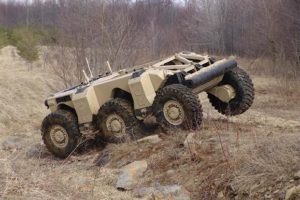The leader of the Army’s push to build next-generation combat vehicles (NGCV) wants robots replacing soldiers in dangerous tactical situations on the future battlefield, noting a need to get after advanced connectivity and real-time mapping solutions.
Brig. Gen. Ross Coffman, director of the NGCV cross-functional team, told attendees at an AUVSI conference the Army is focused on three Robotic Combat Vehicle (RCV) variants for near-term solutions with “perfect” robot solutions likely to arrive in the 2030s with the development of autonomous capabilities.

“Unmanned vehicles are going to change the way we fight our wars,” Coffman said. “I am the biggest advocate for unmanned ground systems at various levels.”
Coffman said the Army’s future fleet of robot vehicles would eliminate the need for humans ins situations from chemical detection missions to dangerous breaching operations.
“Robots will not save the number of people you need, but it will save the people you have by managing risk. We will put robots into very precarious situations,” Coffman said. “Anything that a human should not do on the modern-day battlefield, we want a robot in that space.”
The Army is moving out on its RCV effort to find non-developmental solutions for light, medium and heavy variants, with Coffman adding the vehicles will be payload agnostic, semi-autonomous and integrated with a range of sensors and weapon systems.
A RCV-Light request for white papers was released in June and detailed plans to award up to two prototype contracts for vendors to deliver four test platforms (Defense Daily, May 31). At the end of June, the Army detailed similar plans for the RCV-Medium (Defense Daily, June 7).
Coffman said his team met with vendors who submitted RCV-L white papers last week, and this week was the deadline to submit white papers for RCV-M.
The Army’s current thinking is an RCV fleet would involve two manned controlled vehicles per one robot, but Coffman said his goal to push far past that mark.
“Frankly, I think that’s going to be simple because where I want to go is 12 robots controlled by one human. And I think that’s very doable,” Coffman said. “When? I don’t know. I’m putting 2035 out there, but it could be sooner.”
Current capability gaps include solving the ability maintain connectivity between robots and control vehicles. Coffman said the Army can reach 1.1 or 1.2 kilometers right now, but has set a goal for robots to go out as far as 3 km.
“If I can put a robot forward of humans, in really bad places, to provide us that situational awareness then I have time and maneuver space. I can engage the enemy before the enemy can engage the human in direct fire,” Coffman said.
Coffman noted the Army has the ability now for leader-follower technology, obstacle avoidance and capabilities to program a vehicle route, while seeking solutions for off-maneuver and real-time mapping.
“In a nanosecond we could map terrain in front of us from the air. The ground is really much harder,” Coffman said.